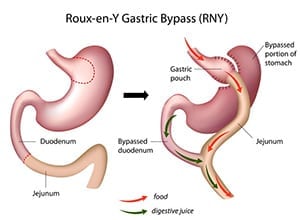
Improve weight loss with the Roux-en-Y Surgery.
The Roux-en-Y, a form of gastric bypass, is a surgical procedure performed for the purpose of encouraging long-term weight loss. It is one of the most common and successful forms of gastric bypass. Roux-en-Y surgery is typically only considered when other weight loss measures have been unsuccessful, such as:
- Diet
- Exercise
- Lifestyle changes
When Is the Roux-en-Y Gastric Bypass Considered?
Obesity is a risk factor for many chronic diseases and can ultimately affect your quality of life. Your health care provider may recommend Roux-en-Y surgery if your body mass index (BMI) is greater than 40 or if your BMI is over 35 and you have been diagnosed with serious health conditions related to obesity such as heart disease, diabetes, high blood pressure, sleep apnea, or severe arthritis.

If you are unaware of your BMI and considering gastric bypass, take your current weight into consideration. This weight-loss surgery is typically only recommended to those who are severely obese, meaning approximately 80 pounds overweight for women and 100 pounds for men.
It is important to keep in mind that this form of gastric bypass is not an instant fix for weight loss, rather, it is a surgical tool to aid in potential weight loss success. You should commit to eating a healthy diet and getting adequate exercise after the procedure is performed.
The best way to determine if you would be a good candidate for this procedure is to talk to your doctor.
Mechanism for Weight-Loss Success
 During the process of digestion, food that is eaten passes into your small intestine via your stomach. This is where the majority of your calories and other nutrients are absorbed. The food then passes into your colon, or large intestine, to allow for the excretion of any remaining waste.
During the process of digestion, food that is eaten passes into your small intestine via your stomach. This is where the majority of your calories and other nutrients are absorbed. The food then passes into your colon, or large intestine, to allow for the excretion of any remaining waste.
During the Roux-en-Y, a small portion of your stomach is used to create a new pouch, similar to the size of an egg. This smaller pouch is then directly connected to the middle portion (Y-shaped) of your small intestine. This bypasses the remaining portion of the stomach and the upper portion of your small intestine, referred to as the duodenum.
Due to the procedure, you will feel full more quickly than prior to surgery due to the reduced size of your stomach. The amount of food you can eat at one time is greatly reduced, leading to weight loss as the amount of fat and calories absorbed is decreased.
Performing The Roux-en-Y Surgery
The surgical method for performing this procedure will be decided by your surgeon. The Roux-en-Y surgery can be performed as an open surgery or via a laparoscopic approach and can take several hours to complete.
During an open surgery, a large incision is made on the abdomen to access the stomach. The laparoscopic approach is less invasive as several small incisions are made to allow access for the laparoscope. The length of hospital stay is typically reduced after a laparoscopic procedure and recovery happens more quickly. Other benefits of the laparoscopic approach include reduced post-surgical pain, less scarring, and a lesser risk of developing an infection or hernia.
Expected Weight Loss and Associated Benefits
 Those who have undergone this surgical procedure typically lose weight quickly directly following surgery. Weight loss occurs more quickly at first, with weight loss generally stabilizing within 18 months to two years.
Those who have undergone this surgical procedure typically lose weight quickly directly following surgery. Weight loss occurs more quickly at first, with weight loss generally stabilizing within 18 months to two years.
Some forms of gastric bypass involve the removal of the stomach and are more restrictive. The Roux-en-Y procedure can be more beneficial as it reduces the size of the stomach, posing fewer surgical risks. It is also more effective than other forms of gastric bypass in the reversal of health conditions caused by severe obesity.
After The Roux-en-Y Gastric Bypass Surgery
 After surgery, you can expect a hospital stay of two to four days. Some belly pain is common so you may need pain medication for the first week or so. Your incisional areas may also be tender and sore. In the following three to six weeks, you will typically only drink liquids or eat pureed foods. After this time period determined by your surgeon, you can slowing add soft food, followed by regular food to your diet.
After surgery, you can expect a hospital stay of two to four days. Some belly pain is common so you may need pain medication for the first week or so. Your incisional areas may also be tender and sore. In the following three to six weeks, you will typically only drink liquids or eat pureed foods. After this time period determined by your surgeon, you can slowing add soft food, followed by regular food to your diet.
Due to the restricted size of your stomach, you will likely be advised to chew food slowly and completely before swallowing. Drinking should be avoided for 30 minutes before and after eating food and you should stop eating once you feel full to prevent stretching of your stomach.
The type of wound care necessary and your activity restrictions will be determined by your surgeon and vary from person to person. If you had an open surgery, you should expect to avoid strenuous activity and heavy lifting during recovery. Most individuals are able to return to normal activities and work after a period of four to six weeks.
As initial weight loss may happen quickly, it is important that you nourish your body with the proper nutrition and vitamins necessary for recovery. Also, as the amount of vitamins and minerals absorbed during digestion is decreased, you will likely continue supplementation indefinitely to avoid any nutritional deficiencies.
Many times, those who undergo this procedure work with a dietician for advice and meal planning. Your health care provider may recommend the following supplements, so be sure to take them as prescribed:
- Daily multivitamins
- Daily calcium and vitamin D supplements
- Iron supplements
- Vitamin B12 supplements
Also, it is recommended that certain blood tests be performed after the Roux-en-Y surgery every six months. This will likely be necessary for the rest of your life so your health care provider can assure you are getting adequate amounts of essential vitamins and minerals.
The exact steps that you need to follow after your surgery will be tailored to you and will be based on your current health and your goals. Be sure to follow your doctor’s instructions carefully for best results.
To learn more about the Roux-en-Y procedure and to explore other methods of weight loss surgery, contact our office today to schedule a consultation.







